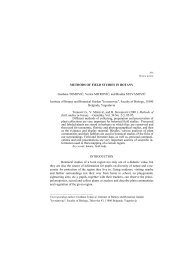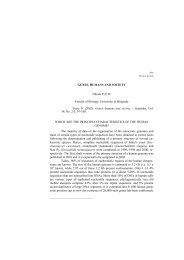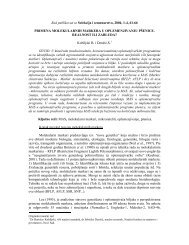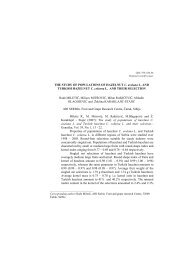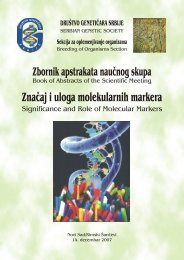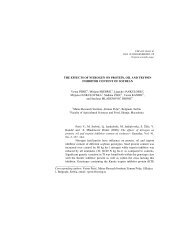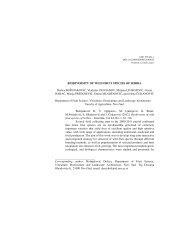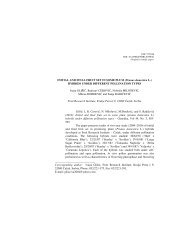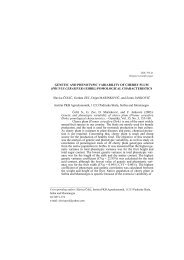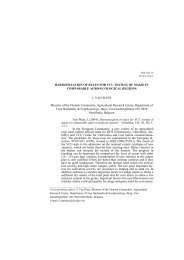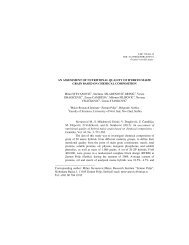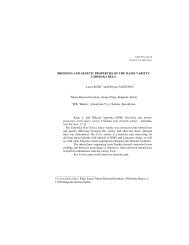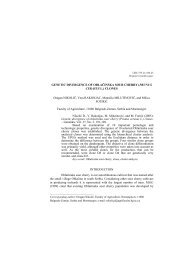Zbornik - Društvo genetičara Srbije
Zbornik - Društvo genetičara Srbije
Zbornik - Društvo genetičara Srbije
Create successful ePaper yourself
Turn your PDF publications into a flip-book with our unique Google optimized e-Paper software.
22 ZBORNIK ABSTRAKATA III KONGRESA GENETIÈARA SRBIJE I-Pos-1<br />
Subotica, 30. novembar - 4. decembar 2004.<br />
EX SITU KONZERVACIJA GENETIÈKIH RESURSA POLJSKOG BRESTA<br />
(Ulmus minor Mill.) I VEZA (U. laevis Pall.)<br />
Jelena Aleksiæ i S. Orloviæ<br />
Univerzitet u Novom Sadu, Poljoprivredni Fakultet,<br />
Institut za nizijsko šumarstvo i ivotnu sredinu, Novi Sad<br />
Cilj našeg istraivanja je ex situ konzervacija genetièkih resursa poljskog bresta (Ulmus<br />
minor Mill.) i veza (U. laevis Pall.) putem osnivanja poljskih banaka gena. Obe vrste su<br />
osetljive na Holandsku bolest brestova (DED) koju izaziva gljiva Opiostoma novo-ulmi<br />
Brasier, iako je druga vrsta više ugroena narušavanjem prirodnih staništa.<br />
Uzorkovanje je sprovedeno u po jednoj populaciji poljskog bresta i veza. Navedena<br />
populacija poljskog bresta, pored pojedinaènih, nasumièno rasporeðenih stabala,<br />
predstavlja jedinu grupu stabala na podruèju Gazdinske Jedinice Vinièna-eravinac-Puk<br />
(ukupna površina 3.552,81ha). Populacija veza se nalazi na površini od 2,43ha i predstavlja<br />
jedinu populaciju veza, pored pojedinaènih, nasumièno rasporeðenih stabala, na<br />
podruèju Gazdinske jedinice Palanaèke ade-Èipski poloj (ukupna površina 1.283,03ha).<br />
Biljni materijal (pupoljci) sa 9 stabala poljskog bresta i 10 stabala veza je iskorišæen za<br />
vegetativnu in vitro propagaciju. Dobijeni klonovi su iskorišæeni za osnivanje poljskih<br />
banaka gena na oglednom dobru Instituta za nizijsko šumarstvo i ivotnu sredinu.<br />
Moguænost naknadne infekcije fungalnim patogenom æe se izbeæi sadnjom klonova na<br />
manjem rastojanju od uobièajenog, pošto je pokazano da tako saðena stabla nisu<br />
atraktivna za brestove potkornjake (Scolytus sp.) koji su vektori bolesti.<br />
Rezutati istraivanja su pokazali da su in vitro tehnike pogodne za masovnu proizvodnju<br />
klonova obe vrste, kao i da se osnivanjem poljskih banaka gena moe uspešno realizovati<br />
ex situ konzervacija genetièkih resursa navedenih vrsta.<br />
EX SITU CONSERVATION OF GENETIC RESOURCES OF FIELD ELM<br />
(Ulmus minor Mill.) AND EUROPEAN WHITE ELM (U. laevis Pall.)<br />
The aim of our research is ex situ conservation of genetic resources of field elm (Ulmus<br />
minor Mill.) and European white elm (U. laevis Pall.) through establishment of field<br />
genebank. Both species are susceptible to Dutch Elm Disease (DED) caused by the vascular<br />
wilt fungus Ophistoma novo-ulmi Brasier, although the later one is more seriously<br />
threatened by the destruction of the natural habitat.<br />
Sampling was conducted in one population of field elm and white elm, respectively. Population<br />
of field elm represents the only one cluster of elm trees, besides solitary, randomly<br />
spread trees, in whole Management Unit Vinièna-eravinac-Puk (total area<br />
3.552,81ha). Population of white elm is spread on 2,43ha and represents the only one<br />
population of elms, besides solitary, randomly spread trees, in whole Management Unit<br />
Palanaèke ade-Èipski poloj (total area 1.283,03ha).<br />
Plant material (buds) from 9 trees of field elm and 10 trees of white elm was used for in<br />
vitro production of clones. Clones were used for establishment of field genebank at Institute’s<br />
of lowland forestry and environment experimental estate. The possibility of further<br />
infection with DED was pass over by planting clones in low hedges, which are unattractive<br />
for the vector of the fungal pathogen – elm bark beetle (Scolytus sp.).<br />
Results pointed out that in vitro techniques are suitable for production of clones in short<br />
time for both elm species and that is possible to preserve elm genetic resources through<br />
establishment of field genebank.



